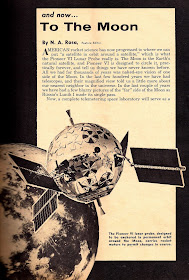I'm not a big electronics expert. I can plug things in. When they quit working, I can throw them away. In between, I know how to turn most electronic things on and off. I may even know how to set the digital clocks on them. But that is about it. So I was never one to read magazines like Electronics Illustrated. But I did (and still do) like to look through them for the many cool pictures they had. And here is a great example of why. After all, if you didn't know, I'm the editor of Rocket Fire Books, and I love anything to do with rockets.
No, that's not George C. Scott dressed up like General Patton on the cover. It's a real military officer pointing to America's Courier satellite. And as it says, this satellite is "the communications brain that receives, remembers and rebroadcasts 75,000 words per minute!"
Sadly, you can see that the public in 1961 has missed the significance of this achievement as a new communications link. After all, it is a telephonic-telegraphic-facsimile repeating station. Considering it carries messages across the world through the sky at nearly 15,000 miles an hour, I can't see how all those people missed this achievement. Perhaps instead of recognizing the impact of this telephonic-telegraphic-facsimile repeating station, they were spending too much time watching Gunsmoke and Wagon Train, the two top shows on TV at the time. (What shocks me is discovering that Have Gun Will Travel, a show I've never enjoyed, eclipsed The Andy Griffith Show for third place. I wish someone would explain that one to me.) So at a time when we were launching this super-sophisticated telecommunications satellite into space, most of the people at home were watching western TV shows. In fact, there wasn't one science fiction show in the top twenty-five shows that year.
Here we see the Pioneer VI sitting atop an Atlas-Able 3-stage rocket. The plan here was to launch this one to the moon--well, at least into lunar orbit, where "it will stay there theoretically forever." Or at least as long as Gunsmoke remained on the air, which it seemed to do metaphorically forever.
Now here, you can see what the Pioneer VI will look like. I notice that the author of this piece says the satellite will orbit the moon practically forever, which seems quite different from theoretically. I wish they'd get their hyperbole straight. Of a more interesting note, you can see where he takes a shot at the Russians, claiming that the only pictures we have of the dark side of the moon are just "a few blurry pictures of the far side of the Moon as Russia's Lunik I made its single pass." We have here a double shot at the Russians. Not only is this an attempt to point out the poor quality of the the Russians' photography skills, but it also points out how they only made one little trip around the moon. And remember, the Pioneer VI will be orbiting the Grand Luna for all eternity (practically and theoretically speaking.)
In all fairness, Pioneer VI has been fairly successful. Though NASA does not regularly check on the telemetry of this satellite, it did make contact with it on December 8, 2000, to celebrate 35 years of continual operation. It is uncertain what Pioneer VI had to say on such an occasion or whether it felt proud of its achievements. Oddly enough, according to Wikipedia, JPL says the Pioneer VI design life expectancy was only six months. Which is no where near forever, whether you are speaking practically or theoretically, or even if you are talking impractically. The only time six months is akin to forever is when you are a kid, and summer is still six months away. Then yes, six months is practically forever.
Now, in case all of this electronics talk has left you with a desire to be a radio and TV repairman, here's a great little offer from Christy Trades School. Get your free illustrated book that shows you how to learn every phase of electrical appliance repair. It doesn't teach you electrical appliance repair, but it teaches you how to learn. In no time you'll be fixing your own appliances, and your neighbor's appliances, all for the amazing figure of $5.00 to $6.00 an hour. And, you'll learn so much, your head will be the shape of a beachball, you'll have no hair, and your eyes will give a clear indication that you've been sticking your finger into one too many light sockets. Don't wait! Write today!





